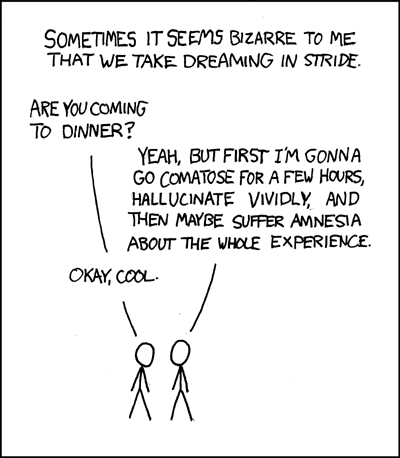 |
| xkcd |
Most of the time, when we dream we are not consciously aware that we are dreaming. Despite the often fantastic circumstances of the dream, we accept that the events and experiences that are happening to us are real. At least until we wake up.
Lucid dreaming, or the awareness that one is dreaming, is a fairly well-known, and well-documented phenomenon. Most people report having at least one lucid dream in their life, but for the most part they are considered to be very rare occurrences in the overall population. However, lucid dreaming was not always a well-accepted fact of life, and of course is still contested by some sleep researchers today.
The term, "lucid dreaming" was originally coined by the Dutch psychiatrist, Frederik van Eeden in 1913, but reports of lucid dreaming have been documented since Aristotle's time. For the better part of the history of research on dreams and sleep many people believed that lucid dreams were not dreams at all, but were the result of brief moments of consciousness due to transitory awakenings that are common during REM sleep.
Then along came Alan Worsley.
Alan Worsley is a bit of a lucid dreaming celebrity in the field. A graduate student in psychology, Worsley had been developing his own ability to dream lucidly. He was able to plan experiments while awake, and then recall and carry out the protocol once dreaming.
During REM sleep, your body paralyzes the motor activity eminating from the spinal cord. This is thought to be because during dreaming motor activities are initiated in the brain in response to dream stimuli, but then they are not propagated beyond the spinal cord so that this (usually) doesn't happen:
However, it is known that not all motor functions are cut off during dreaming. The most obvious being the eye muscles (hence, Rapid Eye Movement) and respiratory muscles. Alan Worsley used this information to signal to an observer in the lab that he was dreaming and aware of it by moving his eyes left and right a pre-agreed upon number of times. By carrying out this procedure with no lapse in sleep activity (as monitored on an electroencephalogram (or EEG)), Worsley effectively proved that lucid dreaming is a physiological reality.
Since Worsely many people have become skilled in lucid dreaming, and indeed it has become accepted as a skill that most people can learn with practice and patience. For most people, lucid dreams initiate when something in the dream is so outside the normal realm of reality that it becomes abundantly clear to the dreamer that he or she is dreaming. You may think that something like a blue whale passing overhead like a blimp might be the sort of stimulus needed to induce that sort of awareness, but really it may in fact be something more mundane that suddenly jolts you into awareness. In the clip from Waking Life that I posted a couple weeks ago, one of the characters suggests turning a light switch off and on. In fact, this is a common method used by lucid dreamers to test waking vs. dreaming states of consciousness. Worsley and other lucid dreamers often report that light levels are hard to adjust in dreams, so turning a light switch on and off is a quick and easy way to test if you are dreaming. If it's a habit you can build in waking life, then you may find one day you try it and the results aren't what you expect, and from there it could be reasonable to conclude that you're dreaming.
Lucid dreaming can also be used as a valuable tool for studying consciousness and its properties both in the waking world and the dream world. In particular, it's interesting to test what can be done in the dream world. Since it exists purely in the mind, one would think that lucid dreaming allows you total control over the circumstances of your dream and you can essentially play God. But in practice, most people seem to have limits to control over their dreams. The light switch is one example, and reflections in a mirror are another.
In one study, dreamers were asked to find a mirror and view their reflection, and then to try and walk through the mirror. Most participants could find the mirror and view their reflection with ease, however most participants also reported distortion in the image they saw in the mirror. When they tried to walk through it, slightly less than half were successful in doing so. What was on the other side varied from person to person. One participant reported coming up from the bottom of a lake after entering the mirror. Others reported moving through the mirror but then ending up back in the same room.
While this is cool and all, the fact still remains that most of the participants could not walk through the mirror. Why? It's a dream so anything should be possible. That's something we generally believe even when dreaming non-lucidly.
The element of control may be in some way related to the level of lucidity. Up until now I have been talking about lucid dreaming as a distinctly different type of dreaming from non-lucid dreaming. But modern research shows that there is a continuum between states of lucidity in dreaming, and that this continuum affects the ability of the dreamer's control over the events of the dream. Theoretically, if one can learn to dream lucidly, one could probably learn to master control over the events in the dream once lucidity is achieved. And then who knows what you could be capable of.
But first, just try to turn the lights on and off.
No comments:
Post a Comment